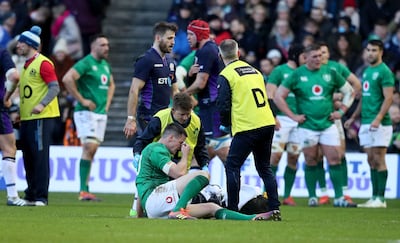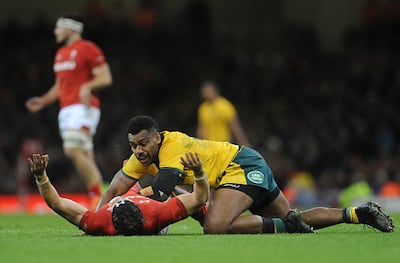Sometimes science is slow to catch up. For example, "these guys are getting bigger, aren't they?" is often heard during the rugby Six Nations, but now evidence supports it.
Thus, a study of international rugby union players in BMJ Open Sport & Exercise Medicine reported that, in 1955, the mean player body mass was 84.8kg, and in 2015 it was 105.4kg, a 24.3 per cent increase. Also, "between 1955 and 2015, the body mass of forwards increased steadily, whereas that of backs has mostly gone up since 1995 [when the game turned professional]".
The authors further state: ". . . it has been suggested that players with greater body-mass index have greater injury incidence and severity. The England Professional Rugby Injury Surveillance Project has not identified an increased incidence of injuries (apart from concussion)."
This project reported: "In 2015-16, the incidence of match concussion rose to 15.8/1,000 hours, which is the highest reported since the start of the injury surveillance project [in 2002] and substantially higher than the mean for the surveillance period as a whole (5.9/1,000 hours)."
Burden
For an Irish perspective, a report in the journal Physical Therapy in Sport describes "the epidemiology of concussion in professional rugby union in Ireland". This study of 160 professional players found 60 concussions in 47 players over the 2016/17 season and concluded: "The burden of concussion in professional rugby union is high. Incidence rates appear to be increasing year on year while severity is unchanged."
The main findings included a match concussion incidence rate of 18.4/1,000 player-match-hours; only 13 per cent of players returned to play at the minimum recommended recovery time of six days; and the tackle was responsible for 70 per cent of concussions (tackler 41 per cent; ball carrier 29 per cent).

Given this last finding, would a change in tackling technique – supported by a rule change – help reduce the incidence of concussion? I asked study co-author Dr Matthew Cosgrave, a GP with a specialist interest in sport and exercise medicine. "A tackle rule change was recently trialled in the RFU's Champions Cup; its aim to reduce concussion incidence through lowering the tackle height. But it was recently announced," he added, "that the initiative was abandoned because although it successfully lowered tackle height, concussion incidence rates actually increased."
These findings, says Dr Cosgrave, indicate that reducing concussion incidence is complex and that we need to explore ways of reducing concussion risk and test them in the real world.
Dr Cosgrave, who undertook the study in partnership with the Irish Rugby Football Union (IRFU) as part of a master's degree in sport and exercise medicine, warned against applying results from this study to non-elite cohorts: "There are many differences between the two populations and the environments in which they play," he said.
Dr Rod McLoughlin, the IRFU's medical director agrees: "It's important," he told The Irish Times, "to underline that these figures are for the professional game, and that injury including concussion is less prevalent in the domestic game, which is played by most people."
Considering the amateur game in Ireland, University of Limerick researchers investigated "current injury monitoring and player education practices in Irish amateur rugby union". In 2018 they reported in Physical Therapy in Sport that 91 per cent of Ireland's top 58 amateur rugby clubs monitor injuries and 36 per cent monitor training load; pre-season concussion screening was conducted in 23 per cent of clubs; injury prevention education was conducted by 71 per cent of clubs; and concussion education was conducted by 82 per cent of clubs.

Cultural change
Turning to Dr Cosgrave’s study of Irish professionals, Dr McLoughlin said: “The IRFU continue to prioritise player welfare in both the professional and domestic game and we were pleased to see that that over half of all recorded incidents in the professional game were reported directly by players. We believe that this is reflective of the cultural change we have been pursuing for many years.”
This is supported by evidence. For example, the IRFU embarked on a concussion education programme before the 2010/11 season, and a 2014 report, "Concussion History and Reporting Rates in Elite Irish Rugby Union Players", in Physical Therapy in Sport found a self-reported concussion rate of 44.9 per cent of players who participated in the 2010/11 IRFU season: "The self-reported concussion rates in this investigation may be partly attributed to better player knowledge about concussion."
Dr McLoughlin, while acknowledging that concussion is an issue for all contact sports, believes that through education and a focus on prevention, based on research and learning, the treatment of head injuries has improved: “As Dr Cosgrave’s study shows, very few players returned to play after the minimum guidelines of six days, which is in line with our player-centred approach to player welfare, which is led by clinical judgment and not recommended guidelines.”
Dr Cosgrave reiterates the close partnership with the IRFU that characterised the study: “It is just one of the many efforts within the IRFU to better understand and manage injuries at all levels in Irish rugby.”
As for possible future research directions, a recently published protocol aims to establish biomarkers in urine and saliva samples to determine the feasibility of undertaking the rapid diagnosis of sports-related concussion, with a view to assisting diagnostic, prognostic and return-to-play decisions.
Meanwhile, enjoy the rugby and . . . these guys are getting bigger, aren’t they?








